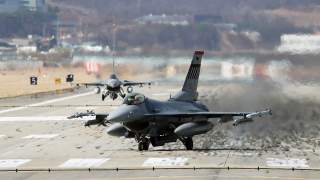Understanding the Case for a Strike on North Korea: Brutality, Rationality and Deterrence
While many public statements from the administration and its allies have suggested one rationale for war, digging into the logic underpinning the “bloody nose” idea suggests another.
Instead, U.S. policy is aimed at changing the status quo by “denuclearizing” North Korea. “Denuclearization” requires either forcibly destroying the country’s entire stockpile of nuclear warheads, their associated delivery systems, and the infrastructure required to regenerate them on the one hand or convincing the regime to do all that itself on the other. The former would be an extraordinarily large undertaking, likely requiring a ground invasion and subsequent occupation as well as the absorption of very high numbers of U.S. and allied casualties; the latter is much more attractive, but requires a North Korea that is subject to influence.
Interestingly, the military option that has been floated does assume a North Korea that’s open to convincing, just perhaps not right now. McMaster and his National Security Council staff developed the idea of a “bloody nose” strategy last summer, and it hasn’t gone away despite either White House denials that such a plan was ever floated or the recent drop-off in tensions between Washington and Pyongyang. The idea would be to launch a limited strike with the purpose not of reducing North Korea’s ability to inflict damage on the United States and/or U.S. allies, but rather of persuading Pyongyang to rethink its strategy by illustrating “the high price the regime could pay for its behavior.”
The fact that we haven’t yet been able to convince the North to do what we want might indicate that the regime doesn’t currently find U.S. threats credible. After all, if Pyongyang perceives no real chance of Washington following through with military punishment if the North continues to defy U.S. demands, why bother complying? (Another, more likely, reason for the North’s continued behavior is the sheer value to the regime of keeping the country’s nuclear weapons and associated delivery systems. According to this argument, there’s little to nothing the United States could threaten in order to successfully convince the North Koreans to give it all up.)
A limited strike of the “bloody nose” variety could actually provide a way to make future U.S. threats credible if that is in fact the problem. In his work on coercive diplomacy, Alexander George lays out the idea of an “exemplary” use of the military instrument, which he describes as “just enough force of an appropriate kind to demonstrate resolution and to give credibility to the threat that greater force will be used if necessary.” According to this line of thinking, the North Koreans would realize that the United States was serious—as in, willing to apply military power to back up coercive threats—and would then finally concede to U.S. demands. Or, failing that, at least provide the administration cover should it wish to pursue still more aggressive U.S. measures.
But the “bloody nose” strategy assumes we can credibly communicate our limited aims to Kim. Only by doing so could we convince him to simply accept a U.S. strike rather than launch a large one of his own in retaliation. Unfortunately, the modern American way of war makes that all but impossible. At the start of any hostilities, U.S. forces would take a number of actions designed to reduce risks to U.S. and allied forces; those same actions would also have the inadvertent effect of suggesting to the adversary more extensive U.S. war aims than we might in fact hold. No foreign leader could risk waiting to find out for sure when the penalty for being wrong could include decapitation. So not only is the desired U.S. end-state in North Korea likely a “pipe dream,” but so is this particular way of trying to achieve it.
Trying (and Failing) to Square the Circle
While many public statements from the administration and its allies have suggested one rationale for war, digging into the logic underpinning the “bloody nose” idea suggests another. Such a strike would be a way of addressing not our inability to convince the North Koreans to maintain the status quo, but rather our ongoing failure to persuade them to change it. And the obstacle such a strike would enable us to overcome isn’t any brutality or irrationality or undeterrability on the North Koreans’ part, but rather a credibility problem on ours.
Unfortunately, there’s likely no way to convince Kim that any U.S. strike is in fact limited, and therefore there’s likely no way to avoid substantial North Korean retaliation or the attendant catastrophic results. We need to nip any second round of “bloody nose” advocacy in the bud—lest we be the ones to come off looking brutal, irrational and undeterrable.
T. Negeen Pegahi is an assistant professor of strategy and the director of the Mahan Scholars research program at the U.S. Naval War College. The views expressed here are her own and do not necessarily reflect those of the Naval War College, the Department of the Navy, the Department of Defense, or the U.S. government.
Image: Reuters

